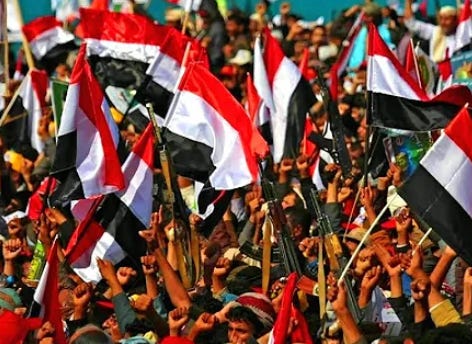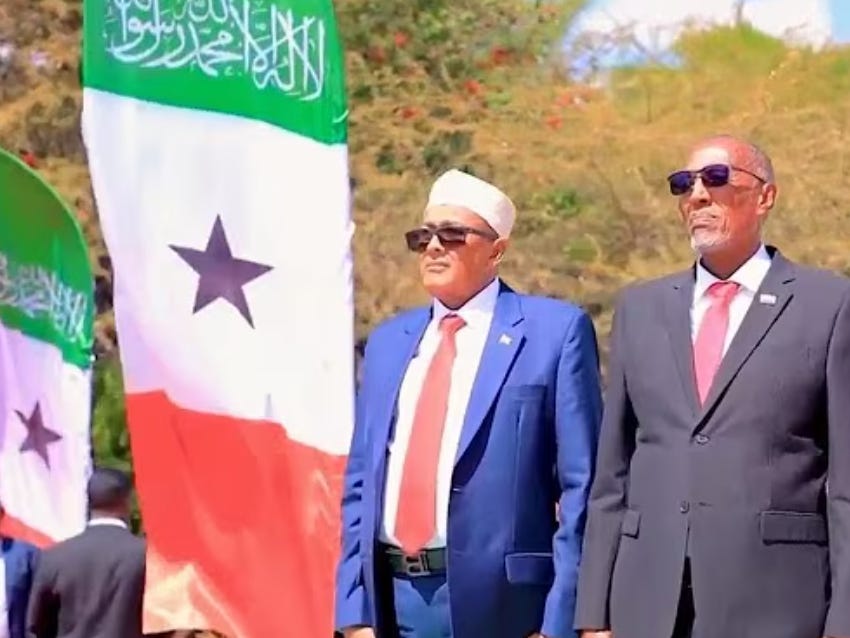Yemen’s Unraveling: A Return to Two States?
From civil war to foreign intervention, Yemen’s slow-motion collapse may end with the revival of its pre-1990 north-south divide.
Global attention remains fixed on Donald Trump's aggressive posture toward the Houthi rebels in Yemen after the U.S. president has approved strikes against the militants in the last few weeks. Additionally, there is increasing speculation that Trump could expand this conflict to Iran — a key ally of the Houthis.
Amidst these war fears, an overlooked yet increasingly plausible outcome is gradually emerging—the permanent division of Yemen into two separate states.
Yemen’s devastating civil war, exacerbated by Saudi Arabia’s military intervention starting in 2015, has created a volatile reality that may not only reshape the country’s map entirely but also be another nail in the coffin of the liberal international order’s holy sacrament of territorial integrity.
Understanding Yemen’s fraught political history is key to appreciating the country’s present descent into political fragmentation. In modern times, Yemen has been marked by numerous political fissures. .
After achieving independence from the Ottoman Empire in 1918, North Yemen initially emerged as the Mutawakkilite Kingdom of Yemen, an absolute monarchy ruled by Imams guided by the precepts of the Zaydi sect of Shia Islam. The religious monarchy lasted until 1962, when it was overthrown by a republican revolution, leading to the establishment of the Yemen Arab Republic. Political tensions remained high as royalist and republican factions duked it out in the North Yemen Civil War (1962-1970) that resulted in the latter coming out on top and consolidating republican governance in North Yemen.
By contrast, South Yemen gained independence from the British Empire in 1967 and subsequently became the People's Democratic Republic of Yemen — the Middle East’s first and only Marxist state. From 1967 to 1990, South Yemen received significant support from the Soviet Union and other Eastern Bloc countries, including military aid, economic assistance, and ideological guidance. However, such patronage began to dry up in the 1980s as the Soviet Union began to economically crumble and political disintegration among its constituent republics and satellite states soon followed.
Ali Abdullah Saleh, who assumed the presidency of North Yemen in 1978, saw where the political winds were blowing and unified both Yemeni states in 1990. Although Saleh’s achievement of unifying Yemen won him international credibility, the unification honeymoon would be rather short.
Saleh’s government was characterized by rampant corruption, petty authoritarianism, and the ham-fisted use of tribal patronage networks that angered many Yemenis. Naturally, sporadic uprisings and a short civil war in 1994 began to expose contradictions in the Yemeni state.
Regionalism would rear its ugly head after the conclusion of the 1994 conflict. Southern Yemenis grew distraught about dismal job and landholding prospects along with a perceived decline in status following the 1994 dustup. This fueled separatist sentiments in the south in the ensuing years.
That said, southern Yemen was not the only part of the country that was disillusioned with the Saleh government’s rule. The Houthi movement (Ansar Allah) entered the political scene in the early 2000s in Yemen’s northern Saada province. This movement was centered on Zaydi Shia revivalism and opposition to the Saleh government.
Hussein Badreddin al-Houthi was the leader of this movement that advocated for the rights of Zaydis. The Houthis were notably critical of the Saleh government’s corruption and alliance with the United States and Saudi Arabia.
After the United States invaded Iraq in 2003, the Houthi’s opposition to the United States hardened. The Houthis not only viewed the United States as an imperial power causing instability in the Middle East, but they treated the Saleh government as an accomplice to Uncle Sam’s perfidy in the Middle East.
Relations between the Saleh regime and the Houthis further deteriorated after the former wrapped up a border dispute with Saudi Arabia. From there, the Yemeni government sought to tighten its grip over the Saada governorate — a well-known Houthi stronghold. Shortly thereafter, the Houthis started to resist the Saleh government’s efforts to suppress them.
In 2004, an open insurgency broke out across the country, marking the first of six intermittent Saada Wars between the Houthis and Saleh’s security forces. In June 2004, government troops were deployed to arrest Hussein al-Houthi, which resulted in heavy fighting that lasted until Hussein was killed in September 2004. From there, Hussein became a martyr for the insurgency and galvanized the resistance to the Saleh government.
Hussein’s brother Abdul-Malik al-Houthi would succeed him as the leader of the resistance movement and continued the insurgency against the Saleh government. Several fare ups broke out between the Saleh government and the Houthi insurgency from 2005 to 2009 that did not end in a conclusive manner.
This conflict expanded in 2009 when Saudi Arabia launched “Operation Scorched Earth” in cooperation with Yemeni forces to crush the Houthi revolt. In late 2009, Houthi rebels crossed the porous Saudi-Yemeni border, launching attacks on Saudi border guards and infrastructure. The spillover of violence from northern Yemen into Saudi territory prompted Saudi Arabia to take action and intervene in Yemen.
A ceasefire was eventually brokered in February 2010, putting a temporary pause to the rebellion. By then, years of sustained fighting provided the Houthis with crucial military experience and strengthened their hold over northern Yemen.
The Arab Spring in 2011 presented the Houthis with a strategic opportunity to broaden their political influence amid widespread protests against President Ali Abdullah Saleh. Under pressure from the Gulf Cooperation Council (GCC), Saleh agreed to step down in 2012 in exchange for immunity, transferring power to his vice president, Abdrabbuh Mansur Hadi.
Hadi’s transitional government proved weak and ineffective in tackling Yemen’s deep-rooted economic challenges and political divisions. One of its key initiatives—a proposal to restructure the country into a six-region federal system—was rejected by the Houthis, who viewed it as a move to diminish their political influence.
With no viable political path to address their grievances, the Houthis resorted to armed action in 2014, seizing control of the capital, Sana’a. By early 2015, they had placed President Hadi under house arrest, effectively toppling the internationally recognized government. As the Houthis pushed further south, capturing more territory, Hadi fled to Aden and eventually sought asylum in Saudi Arabia.
In Washington and Riyadh, officials believed the Houthis’ swift military successes stemmed from a strategic alliance with Iran, despite evidence showing that Iran viewed the Houthis as an ally of convenience and not so much a proxy force to do Iran’s geopolitical bidding. Concerned that Tehran was gaining a foothold on its southern border, Saudi Arabia launched a military intervention in March 2015 —Operation Decisive Storm —to counter the perceived threat.
Partnering with Arab nations including Bahrain, Egypt, Jordan, Kuwait, Morocco, Qatar (until mid-2017), Sudan, and the United Arab Emirates, Saudi Arabia aimed to put Hadi back in power, defeat the Houthi rebels, and curb Iran’s regional influence. Under President Barack Obama, the United States not only endorsed the intervention diplomatically but also supported the coalition with intelligence sharing, aerial refueling, and the provision of advanced weaponry.
By mid-2015, Saudi and Emirati special forces had made significant battlefield gains, assisting pro-Hadi forces in recapturing Aden and much of southern Yemen. Amid this ground operation, the coalition enforced a de facto naval and air blockade on Houthi-controlled territory, with the ostensive aim of preventing the smuggling of Iranian arms.
Despite the widespread destruction wrought by Saudi Arabia and its allies, the war eventually reached a stalemate on both military and political fronts. In the south, the United Arab Emirates—a key member of the coalition—increasingly threw its support behind the Southern Transitional Council (STC), a separatist movement established in 2017 with the aim of restoring an independent South Yemen. Tensions boiled over in January 2018 when Emirati-backed STC forces turned against the Hadi government and seized control of Aden.
A Saudi-mediated deal, known as the Riyadh Agreement, was signed in November 2019 to mend this internal rift. It proposed a power-sharing arrangement that would integrate the STC into the government. However, deep-seated tensions persisted, and the south remained fractured between pro-STC and pro-Hadi factions. By 2020, the UAE had pulled out most of its ground forces, though it maintained significant influence through allied southern militias and strategic control over key areas such as Aden and Socotra Island.
At the heart of this divide was the UAE’s strategic decision to focus on countering Islamist influence—particularly its deep mistrust of Hadi’s allies in the Islah party, the Yemeni branch of the Muslim Brotherhood. Gulf Arab monarchies like the UAE treat the Muslim Brotherhood and similar Islamist parties as existential threats to their domestic power and broader interests in the Middle East. For more than two decades, Emirati authorities have cracked down on their own country’s main Islamist party, also called al-Islah, in an effort to purge the country of Muslim Brotherhood influence
This shift in the UAE’s priorities, along with its aim to control key maritime hubs, led the UAE to gradually scale back its direct military involvement in Yemen starting in mid-2019. By 2020, the UAE had pulled out most of its ground forces, yet it retained substantial influence through its southern proxy forces and maintained control over strategic locations such as Aden and Socotra Island.
What Yemen’s fate will be is anyone’s guess. One thing is clear: The principle of territorial integrity is becoming an afterthought in the rapidly changing world order. It has been a cornerstone of the modern state system and is enshrined in the Article 2 (4) of the United Nations Charter, which bans the threat or use of force against the territorial integrity or political independence of any state.
At its core, territorial integrity consists of the following:
No foreign invasion or occupation: Other states should not invade, occupy, or annex parts of a sovereign country's land.
No support for secessionist movements: States should not back groups trying to break away from another country.
Respect for established borders: Existing, internationally recognized boundaries should be honored unless changed peacefully and through mutual agreements.
However, conflicts in Georgia and Ukraine, on top of the United States’ recognition of Israel’s annexation of the Golan Heights have called into question the staying power of territorial integrity in the multipolar order. In the Yemeni case, the country appears to be inching closer to a reversion to its historical political fault line — a north ruled by the Houthis and a south dominated by separatist factions—echoing the pre-1990 era of two Yemeni states.
It's déjà vu all over again.
NEXT:
The Possible Reasons Donald Trump’s Administration Is Recognizing Somaliland
In a move straight out of left field, the incoming Trump administration is slated to recognize Somaliland as an independent state, according to a report by Semafor.
Are you concerned about your wealth during this times of economic uncertainty?
Allocating parts of your wealth into physical precious metals is your best play.
Whether you are:
An institutional client,
A HNWI or UHNWI,
Or a retail customer,
You should contact my good friend Claudio Grass directly.
Claudio is a veteran precious metal investor and wealth manager who has mastered precious markets and knows how to protect people’s wealth no matter the economic and political circumstances.
He will grant you access to his carefully-selected network of trustworthy partners which he has been working for multiple years.
Claudio will advise you on the best players, the appropriate terms, and the necessary safeguards you must take to protect your wealth.
In addition, he will guide you each step of the way when you buy, sell, and store physical bullion.
Your precious metals will be privately stored in Switzerland outside of the banking system, and you can physically pick them up at the vault anytime at your own convenience.
Are you ready to make your wealth recession-proof?
Do not hesitate to contact Claudio; his initial consultations are free.
Contact him below and tell him that José Niño was your reference:
https://claudiograss.ch/contacts/



